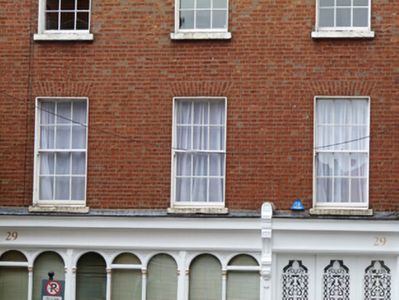Survey Data
Reg No
50020234
Rating
Regional
Categories of Special Interest
Architectural, Artistic, Historical, Social
Previous Name
McCann & Naish
Original Use
House
In Use As
Office
Date
1790 - 1810
Coordinates
315824, 234128
Date Recorded
03/04/2015
Date Updated
--/--/--
Description
Attached three-bay four-storey over basement former house, built c.1800, with shopfront to front (west) elevation added 1896. Now in use as offices. M-profile pitched slate roof, hipped to south and to rear, hidden behind refaced red brick parapet with granite coping, having yellow brick and rendered chimneystack with clay pots. Red brick walls, laid in Flemish bond. Square-headed window openings having raised render reveals, masonry sills, six-over-six pane timber sliding sash windows to first and second floors and replacement uPVC windows to third floor. Arcaded shopfront comprising panelled timber pilasters with decorative brackets framing timber fascia and cornice having lead flashing, surrounding round-headed display windows with timber colonnettes, foliate panels to spandrels, carved timber sill and panelled stall risers having chamfered square-headed recesses with inset cast-ironwork panels. Square-headed door opening having double-leaf timber door with chamfered panels, those to top having inset cast-ironwork panels. Recent steel grille to footpath to front. Situated to east side and centre of Anglesea Street.
Appraisal
Anglesea Street was named after Lord Arthur Annesley, first Earl of Anglesea. It was largely developed by the mid-eighteenth century and appears on John Rocque’s 1756 map of Dublin. A house and yard, occupied by Thomas V. Morris, is recorded on this site in Griffith’s Primary Valuation. Anglesea Street has a well-established history of stockbroking as a result of the opening of the Irish Stock Exchange on the street in 1879. This building was occupied by McCann & Naish, stock and share brokers, from the 1880s. The ground floor was remodelled by Charles Geoghegan for the firm in 1896. The richly ornamented shopfront, enlivened by well-executed cast-ironwork panels, provides an arresting focal point, contributing decorative interest to the streetscape.





















